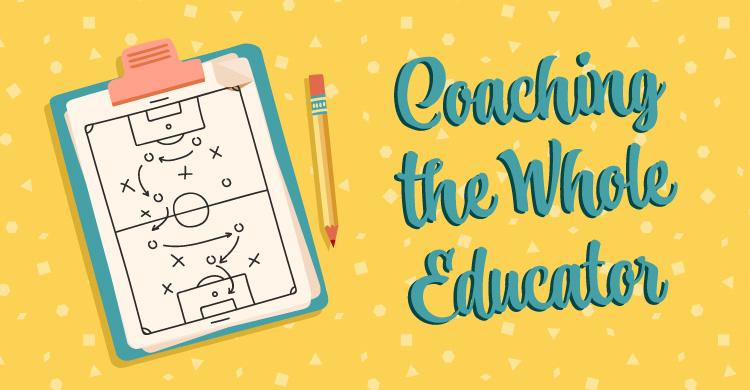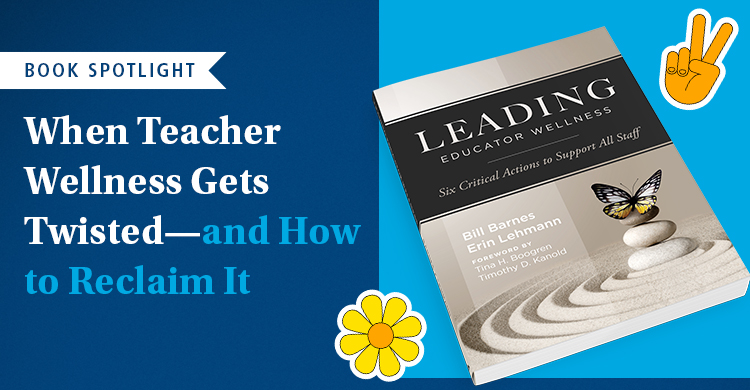After more than two decades in education, I’ve come to discover how much I love, I mean love, to coach. To me, coaching is all about helping someone find their own greatness and it’s this desire that makes me jump out of bed in the morning.
In my former roles as a mentor, instructional coach, and building-level leader, my work was focused on helping both veteran and novice teachers increase their expertise in their use of various instructional strategies or school/district-wide initiatives. We spent our time focused on goal-setting, classroom observations, instructional rounds, and reflections—all in the name of working to increase student achievement.
And it worked.
Sometimes.
But sometimes it didn’t.
And when it didn’t? It wasn’t because the teachers didn’t care or weren’t trying. Not at all. When my coaching didn’t work, it was because the teachers with whom I was working couldn’t concentrate on these instructional strategies or other initiatives because the truth was, their life was falling apart. Or they weren’t sleeping well, or their partner was sick, or their prolonged stress was interfering with their mood or… the list goes on and on. To be honest, learning how to utilize a new instructional strategy was a few steps down on their to-do list as they were at a place where they were just trying to hang on. And I had no idea how to help because my training as a coach was around helping teachers transfer new strategies into their classrooms, not on how to help support teachers’ wellness and address their stress and trauma. In the face of not knowing what to do, I chose to back off. I stopped ‘pushing’ with the instructional goals and instead adjusted my support to providing hugs and leaving chocolate on the desk. But it wasn’t enough, and it didn’t really help.
Learning to think differently
Combining those early experiences of coaching with everything I’ve learned in the last few years about self-care and educator wellness, I’m convinced that we need to think about instructional coaching differently. I now see that coaching needs to be about the whole person, not simply a rigid focus on specific strategies, curriculum, or initiatives. This shift actually mirrors how we’ve adjusted our thinking in the classroom. Rather than keeping a narrow focus centered only around teaching students’ specific content, we’re now thinking about what it means to teach the ‘whole child.’ The whole child approach to education means, ‘Ensuring each child, in each school, in each community, is healthy, safe, engaged, supported, and challenged,’ (www.wholechildeducation.org). I love this. In fact, this is also my greatest hope for shifting how we think about coaching. It’s time for us to learn how to support the ‘whole educator.’ In other words, our coaching models must ensure that each teacher, in each school, in each community is healthy, safe, engaged, supported, and challenged. I firmly believe that when we have healthy, safe, engaged, supported, and challenged teachers, we can more easily do the same for our students.
I believe that we can adjust our coaching in order to meet the needs of the ‘whole educator’ by considering four essential types of support that our teachers need, introduced to us by Lipton and Wellman (2017): physical, institutional, emotional, and instructional.
Essential Supports
Physical support is mainly for beginning teachers and is practical and tangible. It includes navigating the building, gathering resources and materials, and specifically preparing for the start of the school year. Institutional support is essential for beginning teachers and those who are new to the building but have previous experience and involves understanding the culture of a building, establishing systems of support, collaborating with colleagues, and keeping up with education research. Emotional support is especially essential when teachers are struggling, feeling inadequate, questioning their abilities, worn out, and asking themselves, ‘Can I do this?’ This type of support is essential not only for beginning teachers who find themselves struggling, but also includes a focus on educator wellness and self-care, which is essential for all educators, all year long. By engaging in purposeful self-care and wellness routines, teachers can minimize the impact of their struggle on students. This is an area that hasn’t typically been addressed in most coaching models but needs to be, especially now. Finally, instructional support is the type of support that is most directly correlated with student achievement as it involves helping a teacher increase their expertise with the various characteristics of effective teaching. All teachers should receive this essential support throughout their entire career. These four types of support work together, in concert, to address all the unique needs of individual teachers and helps us to reach the goal of ensuring that our teachers are healthy, safe, engaged, supported, and challenged.
The intent of being intentional
As we continue to refine our coaching and support the ‘whole educator,’ we can also go one step further by being purposeful in matching the type of the support to the particular phase that the teacher is in. Utilizing Ellen Moir’s (1999) foundational research around the phases of first-year teachers’ attitudes toward teaching (often lovingly referred to as the ‘dip chart’ because of the shape formed by a graph representing these attitudes), coaches can be intentional in first determining what phase the teacher is in and then matching the support to meet his/her unique needs in that moment. From my work with thousands of educators with varying degrees of experience—from newbies to veterans—I strongly believe that the phases that Moir presents are not unique to new teachers. I posit that experienced teachers also go through these highs and lows throughout the school year and it’s important to be aware of this.
At the start of the school year, teachers are in the Anticipation Phase. Here, there’s an emphasis on providing both physical and institutional support to both beginning and new to the building teachers. From there, we tend to slide into the Survival and Disillusionment Phases, both of which are challenging, for all teachers. Here, a coach starts with emotional support and then provides specific instructional support as needed, to match the concern/challenge. After these challenging phases, we tend to happily move into the Rejuvenation Phase and are open to more intensive instructional support. When we slide down into what I lovingly call ‘The State Testing Slump’ in the Spring, we need a fresh dose of emotional support before we end the year with the Reflection and Second Anticipation Phases which call for both instructional and institutional support.
A new framework
There is no one-size-fits-all approach to coaching, just as there is no one-size-fits-all approach to teaching. Instead, we must work to ensure that we’re helping our teachers bring their very best selves to work each day so that they feel stable and secure enough to engage in the intensive work associated with increasing one’s expertise around pedagogy and instruction. I’m excited to offer a new vision and framework for coaching that focuses on the whole teacher in my forthcoming book, Coaching for Educator Wellness: A Guide to Supporting New and Experienced Teachers (Solution Tree Press, 2021).
ASCD. Whole Child Education, www.wholechildeducation.org/.
Boogren, T. (2021) Coaching for Educator Wellness: A Guide to Supporting New and Experienced Teachers. Bloomington, IN: Solution Tree Press.
Lipton, L., & Wellman, B. (2017). Mentoring matters: A practical guide to learning-focused relationships (3rd ed.). Sherman, CT: MiraVia.
Moir, E. (1999). The stages of a teacher’s first year. In M. Scherer (Ed.), A better beginning: Supporting and mentoring new teachers (pp. 19–23). Alexandria, VA: Association for Supervision and Curriculum Development.






